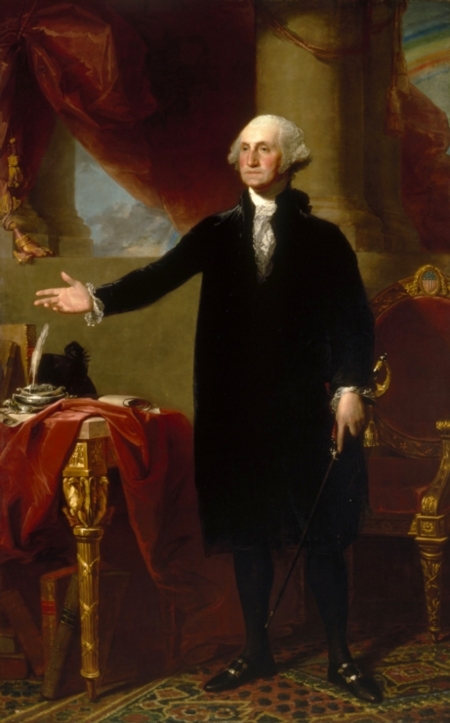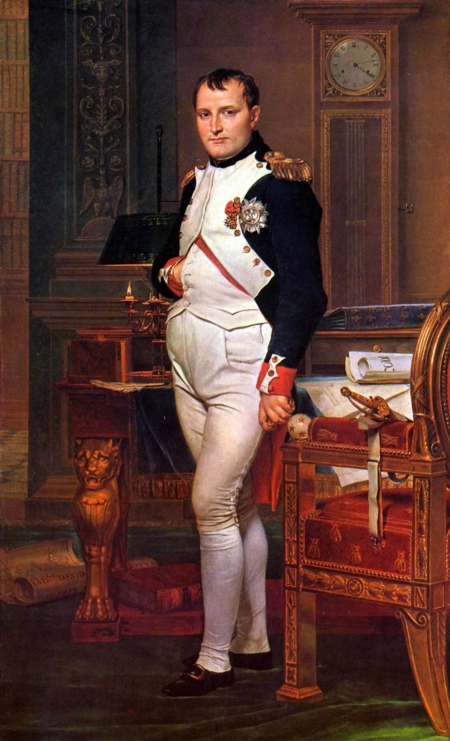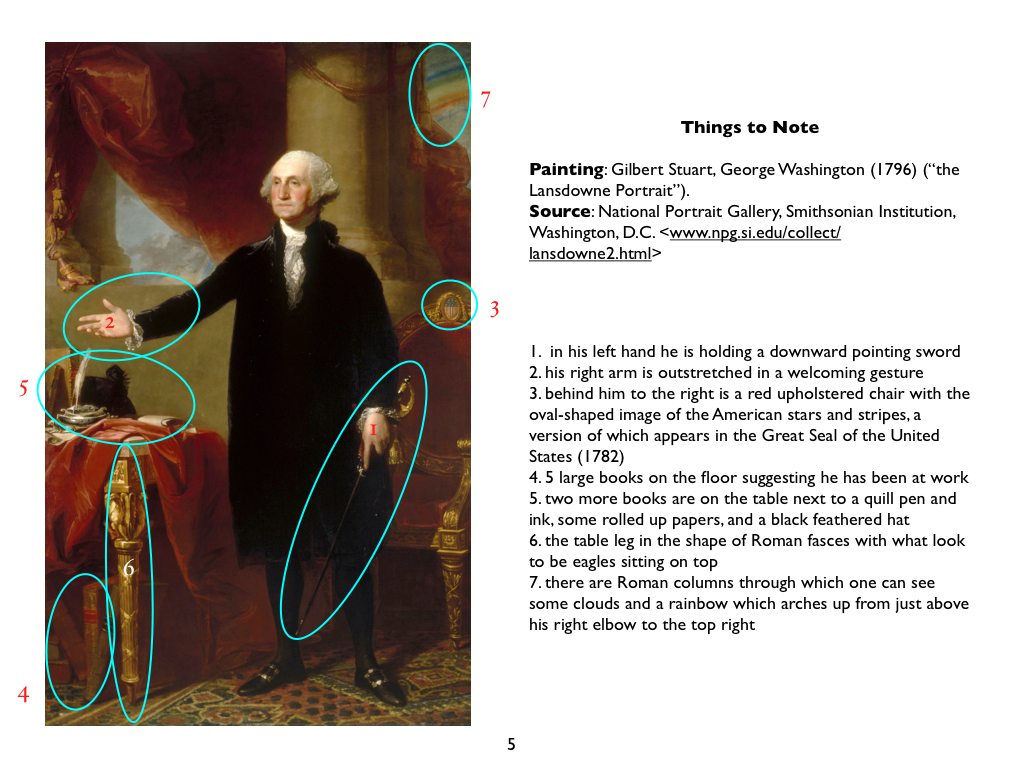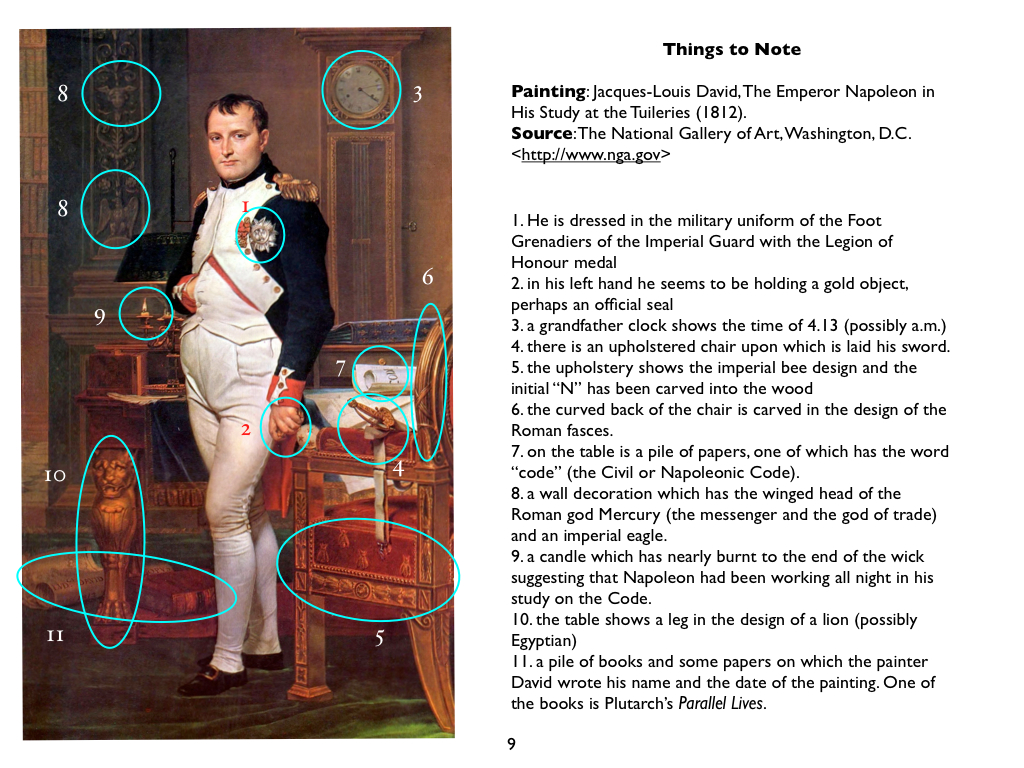Washington and Napoleon in their Study
Introduction
There are some striking parallels in the lives of George Washington (1732-1799) and Napoléon Bonaparte (1769-1821): both were military leaders who helped their countries during a revolution and both came to power as head of a republic which had shaken off the shackles of monarchy. But whereas Washington was content to return to civilian life and promote the development of the new republican institutions of the U.S., Napoleon sought to centralize power in his own hands as First Consul and then as a self-crowned Emperor of the French. The former remained a staunch republican whilst the latter turned into a military tyrant. Washington in his "Farewell Address" of 1796 warned of the dangers to the new republic of trying to behave like a traditional European power with "entangling alliances" which would suck it into wars and international conflicts. Napoleon on the other hand sought to use military force to "free" Europe from "feudalism," from Spain in the west to Russia in the east. Possibly by the time the portrait of Napoleon was painted (some 8 years after the events depicted in the painting took place) he sensed that his imperial ambitions might lead to naught and that his most enduring legacy would be the legal reform he introduced with the Civil Code.
[See the Study Guide for these images PDF 1.27 MB - it contains a highlighted list of "Things to Note" in the picture]
A Comparison of Portraits of Washington (1796) & Napoleon (1812) in their Studies
 |
 |
|
Gilbert Stuart, George Washington (1796)
(“the Lansdowne Portrait”) |
Jacques-Louis David, The Emperor Napoleon in His Study at the Tuileries (1812)
|
1. Gilbert Stuart, George Washington (1796) (“the Lansdowne Portrait”)
[A higher resolution of this image is available - 2076 x 3334 px 3.9 MB JPG]
Source
National Portrait Gallery, Smithsonian Institution, Washington, D.C. www.npg.si.edu/collect/lansdowne2.html
Description
Washington served as the first president of the United States from 1789 to 1797 which means that this painting was made towards the end of his period in office. Washington is dressed in a black velvet suit with a white shirt, black stockings, and black shoes with gold buckles. He is standing on a large woven carpet and is not smiling and has a expressionless face. In his left hand he is holding a sword; his right arm is outstretched in a welcoming gesture. Behind him to the right is a red upholstered chair with the oval-shaped image of the American stars and stripes, a version of which appears in the Great Seal of the United States (1782). To the left is a table with a red cover which has been lifted up in one corner to reveal 5 large books on the floor suggesting he has been at work. Two more books are on the table next to a quill pen and ink, some rolled up papers, and a black feathered hat. The lifted up table cloth also shows the table leg in the shape of Roman fasces with what look to be eagles sitting on top. In the background there are Roman columns through which one can see some clouds and a rainbow which arches up from just above his right elbow to the top right.
Analysis
The painting shows Washington as a “working President” who has been writing a report or proposal of some kind requiring considerable research. The most important thing Washington wrote in 1796, on which he might have been working in the painting, is his “Farewell Address” which was published in September. It has been suggested that the 2 books on the table might be a copy of The Federalist and the Journal of Congress. His simple attire is in keeping with enlightened notions of simplicity, frugality, and an avoidance of old regime regal luxury. There are 2 references to Roman traditions with the table leg fasces (a symbol of republican strength where multiple wooden rods are tied into an unbreakable bunch) and the Roman-style columns. Roman models were chosen for American political bodies such as the Senate, the Capitol building, and for architectural design of public buildings. The rainbow in the background is an allegory that suggests that the political and military storm which had wracked the new republic during its war with great Britain was now over and that a “new era” of freedom was dawning.
[an image from the Study Guide PDF which highlights important "Things to Note" in the image].

Online Resources
- Washington’s Bio page with links to his collected writings (1889, 14 vols.) and other works
- Washington’s Farewell Address (1796)
- The Federalist (1788)
- The Records of the Federal Convention of 1787, ed. Max Farrand
- Topic: The American Revolution & Constitution
- Schools of Thought: The Founding Fathers
2. Jacques-Louis David, The Emperor Napoleon in His Study at the Tuileries (1812)
[A higher resolution of this image is available - 1576 x 2596 px 418 KB JPG - it contains a highlighted list of "Things to Note" in the picture]
Source
The National Gallery of Art, Washington, D.C. https://www.nga.gov
Description
Emperor Napoleon is standing in his study after having worked all night on developing the Civil Code (which was promulgated in 1804). His hair appears to be messed up and he sports a five o’clock shadow (or in this case a “four o’clock shadow”). He is dressed in the military uniform of the Foot Grenadiers of the Imperial Guard with the Legion of Honour medal which he had awarded to himself. His right hand is tucked into his jacket and in his left hand he seems to be holding a gold object, perhaps an official seal. In the background to his left there is a grandfather clock which shows the time of 4.13 (possibly a.m.) and an upholstered chair upon which is laid his sword. The upholstery shows the imperial bee design; the initial “N” has been carved into the wood and the curved back of the chair is carved in the design of the Roman fasces. On the table is a pile of papers, one of which has the word “code”. To his right is a wall decoration which has the winged head of the Roman god Mercury (the messenger and the god of trade) and an imperial eagle. Immediately below that there is a candle which has nearly burnt to the end of the wick suggesting that Napoleon had been working all night in his study on the Code. The table shows a leg in the design of a lion (possibly Egyptian) and underneath is a pile of books and some papers on which the painter David wrote his name and the date of the painting. One of the books is Plutarch’s Parallel Lives.
Analysis
Napoleon was First Consul of France (1799-1804) and then Emperor (1804-1815). In this painting he is shown as very much a “working emperor” having stayed up all night working on his reform of the French legal system (the “Napoleonic” or Civil Code which was promulgated in 1804). He has been consulting large legal books and possibly annotating the drafts of the code written by expert lawyers. He is dressed as a simple solider, avoiding the monarchical symbols and attire he wore in other paintings at the time of his coronation as Emperor in 1804 (compare François Gerard, Napoleon in his Coronation Robes (1804)). There is an understated theme of militarism and imperialism with the imperial eagle, the Roman fasces, the Egyptian lion, the copy of Plutarch’s Parallel Lives, and his simple military uniform and single medal. It seems that in 1812 (when this painting was painted), close to his defeat in Russia and the ultimate end of his Empire, Napoleon wanted to return to an earlier period and to depict himself as an enlightened reformer working on one of his greatest legacies to the French nation.
[an image from the Study Guide PDF which highlights important "Things to Note" in the image].

Online Resources
- Napoleon’s Civil Code (1804) - an official government issued edition of 1805 and an English translation of 1827.
- Topic: The French Revolution
- Debate: The Debate about the French Revolution
- Plutarch's Lives